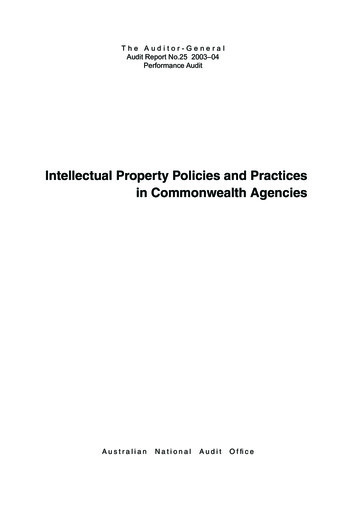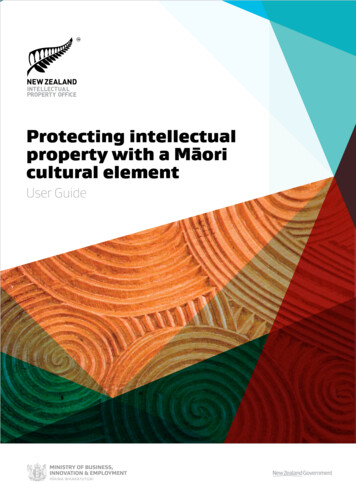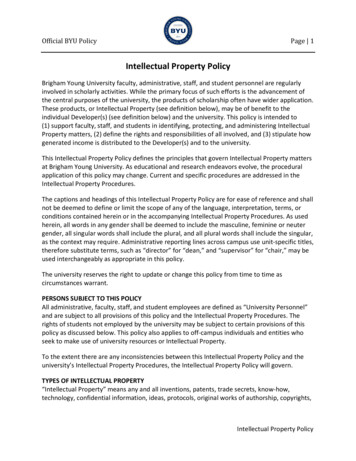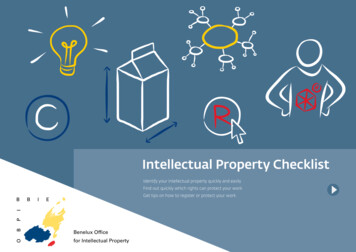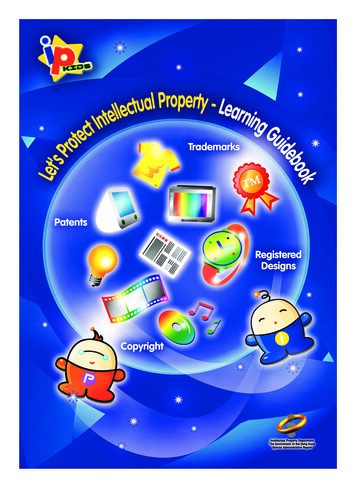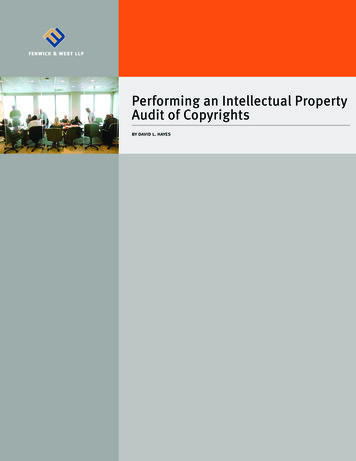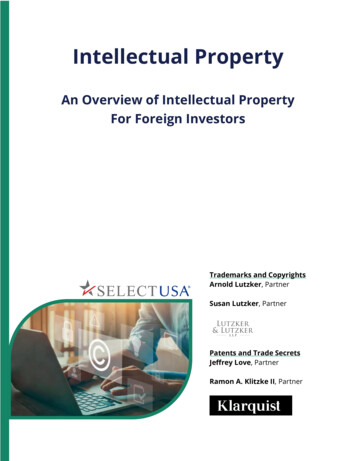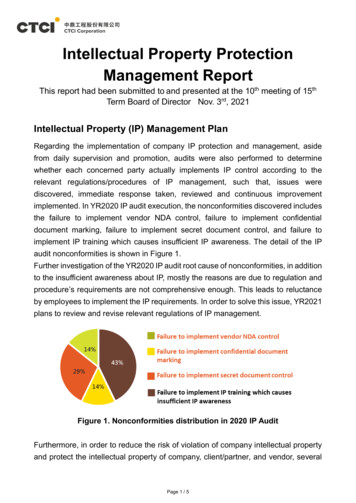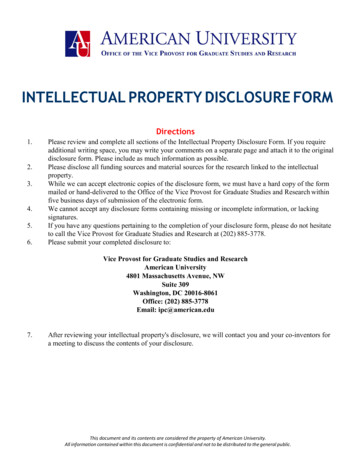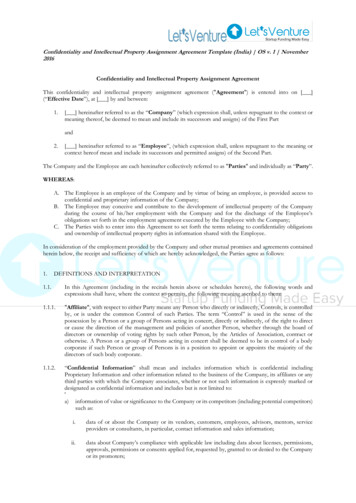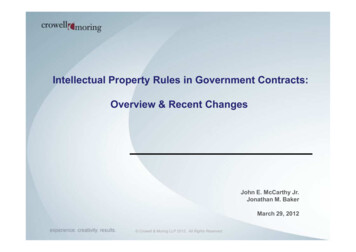
Transcription
Intellectual Property Rules in Government Contracts:Overview & Recent ChangesJohn E. McCarthy Jr.Jonathan M. BakerMarch 29, 2012 Crowell & Moring LLP 2012. All Rights Reserved.
Agenda»»»»»»Rights in technical data & computer softwareDistinction between commercial & non-commercial itemsEffect of NDAA for FY 2012 on data rights schemePatent rightsPractical & strategic considerationsQuestions2 Crowell & Moring LLP 2012. All Rights Reserved.
Government Intellectual Property Rights» Two general categories of government IP issues:– Rights in Technical Data and Computer Software– Patent Rights3 Crowell & Moring LLP 2012. All Rights Reserved.
Rights in Technical Data and Computer Software»»»»»»»Background & DefinitionsRights Allocation SchemeHow Do You Determine What the USG Gets?Traps for the UnwaryOther ConsiderationsCommercial ItemsSummary4 Crowell & Moring LLP 2012. All Rights Reserved.
Rights in Technical Data and Computer Software»»»»»»»Background & DefinitionsRights Allocation SchemeHow Do You Determine What the USG Gets?Traps for the UnwaryOther ConsiderationsCommercial ItemsSummary5 Crowell & Moring LLP 2012. All Rights Reserved.
Rights in Technical Data & Computer SoftwareBackground» Different Rules for– Civilian Agencies (FAR) v. DOD (DFARS)– Technical Data v. Computer Software– Commercial Items v. Non-Commercial Items» Unique Federal Scheme– Rights allocation unique» Standard contract clauses– Different for DOD and civilian agencies» Analogous to, but different from, copyright and trade secretprotection6 Crowell & Moring LLP 2012. All Rights Reserved.
Rights in Technical Data & Computer SoftwareDefinitions» Technical Data– Recorded information only– Does not apply to the item or component itself– Does not include financial, cost, pricing, management, orcontract administration data– Includes data bases and computer software documentation7 Crowell & Moring LLP 2012. All Rights Reserved.
Rights in Technical Data & Computer SoftwareDefinitions» Computer Software (FAR 52.227-14)– “Computer programs that comprise a series of instructions, rules,routines, or statements, regardless of the media in whichrecorded, that allow or cause a computer to perform a specificoperation or series of operations;” and– “Recorded information comprising source code listings, designdetails, algorithms, processes, flow charts, formulas, and relatedmaterial that would enable the computer program to beproduced, created, or compiled.”– Excludes data bases and computer software documentation– DFARS (252.227-7013 ) essentially the same8 Crowell & Moring LLP 2012. All Rights Reserved.
Rights in Technical Data and Computer Software»»»»»»»Background & DefinitionsRights Allocation SchemeHow Do You Determine What the USG Gets?Traps for the UnwaryOther ConsiderationsCommercial ItemsSummary9 Crowell & Moring LLP 2012. All Rights Reserved.
Rights Allocation Scheme» Contractor gets title!!!!» Government gets a license» Three general categories of government license rights intechnical data and computer software– Unlimited rights– Limited rights (technical data)/Restricted rights (computer software)– Government purpose rights10 Crowell & Moring LLP 2012. All Rights Reserved.
Unlimited Rights» USG has the right to do whatever it wants with thedata/software– E.g., Right to publish in the New York Times» USG can grant third parties rights as well– No rights automatically granted to third parties But see L3 Comm. Westwood Corp. v. Robichaux11 Crowell & Moring LLP 2012. All Rights Reserved.
Limited Rights May be reproduced or used by the USG May not be disclosed outside the USG or used for manufacture FAR Exception (FAR 52.227-14, Alt. II)– Other permitted uses may be listed in the contract DFARS Exceptions (DFARS 252.227-7013(a)(14))––––Emergency repairTo USG support contractorTo foreign government if in the interest of the U.S.Subject to certain restrictions and contractor notification– Recent Change to authorizing statute, 10 U.S.C. 2320– Authorizes release/disclosure if necessary for the segregation from, orreintegration of the item or process (or equivalent) with other items orprocesses12 Crowell & Moring LLP 2012. All Rights Reserved.
Restricted Rights Software» USG may:– Use a computer program with one computer at one time May not be accessed, at one time, by more than one terminal or CPU May not be time shared– Transfer to another USG agency computer– Make copies for safekeeping (archive), backup, or modificationpurposes– Modify computer software– Disclose to service contractors– Permit service contractors to use computer software todiagnose/correct deficiencies, or to modify to respond to urgenttactical situations– Disclose to contractors for emergency repair and overhaulDFARS 252.227-7014(a)(15)13 Crowell & Moring LLP 2012. All Rights Reserved.
Government Purpose Rights» Right to use within the USG without restriction, and» Right to authorize others to use for any USG purpose– Primarily for reprocurement purposes14 Crowell & Moring LLP 2012. All Rights Reserved.
Rights in Technical Data and Computer Software»»»»»»»Background & DefinitionsRights Allocation SchemeHow Do You Determine What the USG Gets?Traps for the UnwaryOther ConsiderationsCommercial ItemsSummary15 Crowell & Moring LLP 2012. All Rights Reserved.
A Tale of Two Types of Agencies » Contrast between DOD and civilian agencies– DOD – what the USG paid for (DFARS)– Civilian Agencies – what the contract required (FAR)16 Crowell & Moring LLP 2012. All Rights Reserved.
Determining When the USG Gets UnlimitedRights in Technical Data– DFARS Developed exclusively with Government funds– FAR First produced in the performance of a government contract Irrespective of funding– Other specific categories delivered under thecontract, for example Form, fit and function data Manuals or instructional and training materials for installation,operation, or routine maintenance or repair17 Crowell & Moring LLP 2012. All Rights Reserved.
Determining When the USG Gets UnlimitedRights in Software under the DFARS» USG gets unlimited rights in:– Computer software developed exclusively with USG funds– Computer software documentation required to be delivered underthis contract– Corrections or changes to computer software or computer softwaredocumentation furnished to the Contractor by the USG– Computer software when limitations expire (e.g., governmentpurpose rights)DFARS 252.227-7014(b)(1)18 Crowell & Moring LLP 2012. All Rights Reserved.
Determining When the USG Gets Limited Rights inTechnical Data» DFARS 252.227-7013(b)(3)– Developed at private expense– 252.227-7013(b)(3)» FAR– Not developed in the performance of a contract; and– Developed at private expense– FAR 52.227-14(a)19 Crowell & Moring LLP 2012. All Rights Reserved.
Rights in Technical Data & Computer SoftwareGovernment Purpose Rights – DFARS» Government Purpose Rights is generally a DFARSconcept» Developed with mixed funding– Some government– Some private/indirect» Item, component, or process developed with mixedfunding» Technical data developed with mixed funding wherecontract does not require the development, manufacture,construction, or production of items, components, orprocesses20 Crowell & Moring LLP 2012. All Rights Reserved.
Rights in Technical Data & Computer SoftwareGovernment Purpose Rights – FAR» Cosponsored research and development– Contractor required to make substantial contributions of funds orresources, and– Contractor’s and the Government’s respective contributions notreadily segregable» Contracting Officer may negotiate less rights thanunlimited rights– Such rights should, at a minimum, assure use of the data foragreed-to Governmental purposes (including reprocurementrights as appropriate)FAR 27.408(a)21 Crowell & Moring LLP 2012. All Rights Reserved.
Rights in Technical Data & Computer SoftwarePrivate Expense Determination» Developed exclusively at private expense– “was accomplished entirely with costs charged toindirect cost pools, costs not allocated to agovernment contract, or any combination thereof”DFARS 252.227-7013(a)(8)» Private expense determinations should be made at thelowest practicable level» Segregability» For fixed price contracts, if costs exceed fixed price,additional costs not considered for rights allocation22 Crowell & Moring LLP 2012. All Rights Reserved.
Rights in Technical Data & Computer SoftwarePrivate Expense DeterminationGovernment ExpensePrivate ExpenseUnlimited RightsLimited or Restricted RightsMixed USG/Private ExpenseUSG ExpenseGovernment Purpose RightsUnlimited Rights23 Crowell & Moring LLP 2012. All Rights Reserved.
When Is An Item, Component, or Process“Developed”?» An item, component, or process exists and is workable» The item or component must have been constructed orthe process practiced» Workability is generally established when the item,component, or process has been analyzed or testedsufficiently to demonstrate to reasonable people skilledin the applicable art that there is a high probability that itwill operate as intended– It need not be actually reduced to practiceDFARS 252.227-7013(a)(7)24 Crowell & Moring LLP 2012. All Rights Reserved.
When Is Software “Developed”?» Computer program– Successfully operated in a computer and tested To demonstrate to reasonable persons skilled in the art Program can reasonably be expected to perform its intendedpurpose» Computer software– No operation required– Only “tested or analyzed”» Computer software documentation– Written in any mediumDFARS 252.227-7014(a)(7)25 Crowell & Moring LLP 2012. All Rights Reserved.
Examples of “Developed”» Applied Devices Corp., B-187902, 77-1 CPD ¶ 362– Breadboard of a radar set deemed to be developed– Subsequent government funds to convert to a manufactured itemdid not give government unlimited rights» Dowty Decoto, Inc. v. Dep’t. of the Navy, 883 F.2d 774(9th Cir. 1989)– Aircraft “repeatable holdback bars” achieved workability prior togovernment funded improvements improved performance26 Crowell & Moring LLP 2012. All Rights Reserved.
Rights Determination SummaryTechnical DataComputer SoftwareLimited Rights (Technical Data)FARDFAR Developed at private expenseand not developed inperformance of a contract Includes minor modifications Gov’t may use or reproduce;may not disclose outside gov’tor use for manufacture (otherpermitted uses listed in clause) Developed at private expense Properly marked Gov’t may use, modify, reproduce,release, perform, display, or disclosewithin the gov’t; may not discloseoutside gov’t or use for manufacture(with limited exceptions such asemergency repair and foreign gov’t)Restricted Rights (Computer Software)FARDFAR Developed at private expense and Developed exclusively atprivate expense Gov’t may: access by onecomputer at a time; backup /archive; modify and disclose forservice; disclose to contractorsfor emergency repair / overhaulnot developed in performance of acontract Includes minor modifications Gov’t may use on main computer,for backup / archive; may modify,adapt, and combine with othersoftware; may disclose for serviceUnlimited RightsFAR First produced in performanceof a gov’t contract, irrespectiveof funding; all other datadelivered unless marked “First produced” is broadUnlimited RightsDFAR Developed exclusively with gov’tfunds or publicly available, exceptdetailed process / manufacture data “Developed” ‘s “workable” andneed not be reduced to practiceGovernment Purpose RightsFAR Applies to cosponsoredresearch and development Right to unlimited use withinthe gov’t and for gov’t purposeby any others (reprocurement)DFAR Applies to component or processdeveloped with mixed funding ortechnical data developed with mixedfundingFAR First produced in performance ofa gov’t contract, irrespective offunding; all other data deliveredunless marked “First produced” is broadDFAR Developed exclusively withgov’t funds or documentationrequired to be delivered underthe contract “Developed” ‘s programs run,software source code exists, anddocumentation is writtenGovernment Purpose RightsFAR Applies to cosponsored researchand development Right to unlimited use within thegov’t and for gov’t purpose by anyothers (reprocurement)DFAR Applies to component orprocess developed with mixedfunding or technical datadeveloped with mixed funding27 Crowell & Moring LLP 2012. All Rights Reserved.
Rights in Technical Data and Computer Software»»»»»»»Background & DefinitionsRights Allocation SchemeHow Do You Determine What the USG Gets?Traps for the UnwaryOther ConsiderationsCommercial ItemsSummary28 Crowell & Moring LLP 2012. All Rights Reserved.
Traps for the Unwary» Marking Requirements (Notice)» Maintaining Records» Special Data Rights Clauses29 Crowell & Moring LLP 2012. All Rights Reserved.
Notice/Marking» Must provide notice and mark data exactly as required orrisk a grant of unlimited rights to the government– Unlabeled data is unlimited rights data» Bright line rule» Proposal must include table identifying what data/software isbeing provided with other than unlimited rights30 Crowell & Moring LLP 2012. All Rights Reserved.
Marking RequirementsNoncommercial Computer Software» Contractor may only assert restrictions on theGovernment’s rights to use, modify, reproduce,release, perform, display, or disclose computersoftware by marking the deliverable software ordocumentation subject to restriction» Exception:– Instructions that interfere with or delay operation of computersoftware in order to display markings must not be inserted insoftware that “will or might be used in combat or situations thatsimulate combat conditions”DFARS 252.227-701431 Crowell & Moring LLP 2012. All Rights Reserved.
Validation of Marking Requirements» Government may require contractors to provide data tojustify restrictive markings– Failure to respond may provide a basis for questioning restrictions– May result in government unilaterally modifying an asserted markDFARS 227.7103-13; FAR 52.227-14(e)32 Crowell & Moring LLP 2012. All Rights Reserved.
Government Challenge Procedures» The USG challenge must– Be in writing– Provide basis for the challenge» The Contractor is required to respond within 60 days providingjustification for the marking» The Contracting Officer may– Extend the time for a response– Request additional supporting documentation» The Contracting Officer must issue a final decision» USG will honor the asserted restriction during any appeal of thatfinal decision» USG deals directly with subcontractors/suppliers in challenging suchrestrictionsDFARS 227.7103-13; FAR 52.227-14(e)33 Crowell & Moring LLP 2012. All Rights Reserved.
Practical Pointers for Contractors» Mark the data/software you are delivering to the USG– Mark when data/software is created– When in doubt -- mark» Use the required FAR/DFARS labels– Do not get creative» Have a gate keeper for communications with the USG– Avoid direct Contractor engineer to USG engineer electronic orpaper correspondence34 Crowell & Moring LLP 2012. All Rights Reserved.
Traps for the Unwary» Marking Requirements (Notice)» Maintaining Records» Special Data Rights Clauses35 Crowell & Moring LLP 2012. All Rights Reserved.
Maintaining Records» Contractors need to maintain an accounting system totrack what is:– Developed in the performance of a contract– Developed exclusively at private expense» DFARS Requirement (DFARS 252.227-7019(b))“The Contractor shall maintain records sufficient to justify the validityof any markings that assert restrictions on the Government's rightsto use, modify, reproduce, perform, display, release, or disclosecomputer software delivered or required to be delivered under thiscontract and shall be prepared to furnish to the Contracting Officer awritten justification for such restrictive markings in response to arequest for information”36 Crowell & Moring LLP 2012. All Rights Reserved.
Practical Pointers for Contractors» Upfront planning required to maximize Company’s rightsin technical data and computer software» Define scope of each development effort, whether inhouse or under contract» For in-house development work, make sure there is noUSG requirement covering the same work» For each development contract, make sure there is noongoing in-house development effort addressing thesame scope of work» Design modifications – must use the same analysis37 Crowell & Moring LLP 2012. All Rights Reserved.
Practical Pointers for Contractors» Track the development effort from a technical standpointto make sure that it stays consistent with the originalcharter– If the technical team wants to deviate, the upfront analysis mustbe repeated» Maintain separate charge accounts for each newdevelopment effort and charge time and expensesaccordingly» Maintain traceability between the charge accounts andthe technical documentation– Put charge codes on technical data/software when created» Retain the development records (technical andaccounting)– Exclude from document destruction policies» Critical to maintain accurate configuration managementcontrols38 Crowell & Moring LLP 2012. All Rights Reserved.
Practical Pointers for Contractors» Use private funds for the core development effort wherepossible» Maintain and upgrade those core components usingprivate funds where possible» Minimize the use of private funds to fund subcontractorefforts under a government contract» Where subcontractor effort required and private fundsused, carve that portion out of contract with thegovernment and have separate contract with thesubcontractor for that effort– Include commercial, work for hire, IP provisions– Do not include FAR/DFARS clauses39 Crowell & Moring LLP 2012. All Rights Reserved.
Practical Pointers for Contractors» Records should include tracking of:––––Contract requirementsInternal research and development requirementsTechnical development achievements and associated timelinesWho paid for what» Carefully plan modifications of:– Limited rights items, components or processes and associatedtechnical data– Restricted rights software» Data rights determination made at the lowest readilysegregable unit40 Crowell & Moring LLP 2012. All Rights Reserved.
Traps for the Unwary» Marking Requirements (Notice)» Maintaining Records» Bad Clauses41 Crowell & Moring LLP 2012. All Rights Reserved.
Bad Clauses» Rights in Data – Special Works (FAR 52.227-17)– Grants the government unlimited rights in All data delivered under the contract All data produced in the performance of thecontract– Limits contractors’ use of data to performance of thecontract absent express Government authorization– Restricts right to copyright assertion42 Crowell & Moring LLP 2012. All Rights Reserved.
Bad ClausesReach-Back Clauses» Generally contractors may control USG rights by limitingthe data that is delivered to the USG» Reach-back clauses allow the government to requiredelivery of data produced or used in the performance ofthe contract– DFARS 252.227-7026, Deferred delivery clause (2 years; onlypre-designated tech data and computer software)– DFARS 252.227-7027, Deferred ordering clause (3 years; anytech data or computer software generated in the performance)– FAR 52.227-16, Additional Data Requirements (3 years; “anydata first produced or specifically used in the performance ofth[e] contract”)43 Crowell & Moring LLP 2012. All Rights Reserved.
Bad ClausesAgency-Specific Clauses» Agencies occasionally include agency-specific clauseswhich further limit contractor’s rights in technical data andcomputer software44 Crowell & Moring LLP 2012. All Rights Reserved.
Practical Pointers for Contractors» Review IP clauses before submitting proposal or signingcontract/task order/modification» If you can, take exception to the “bad” clauses– Ask the USG to delete them– Caution: In a competition, taking exception may make yourproposal non-compliant45 Crowell & Moring LLP 2012. All Rights Reserved.
Rights in Technical Data and Computer Software»»»»»»»Background & DefinitionsRights Allocation SchemeHow Do You Determine What the USG Gets?Traps for the UnwaryOther ConsiderationsCommercial ItemsSummary46 Crowell & Moring LLP 2012. All Rights Reserved.
Other Considerations» License Rights versus Delivery» Specifically Negotiated Rights» Subcontractor Rights47 Crowell & Moring LLP 2012. All Rights Reserved.
License Rights versus Delivery» License Right to Require Delivery» Delivery governed by contract requirements– Negotiate delivery requirements carefully (e.g., source code)» Carefully control delivery of technical data and computersoftware– Deliver only what is required» Can get additional compensation for additional deliveryrequirements» Beware of reach back clauses48 Crowell & Moring LLP 2012. All Rights Reserved.
Recent Developments» NDAA for FY 2012 revised authorizing statute, 10 U.S.C.2320– Authorizes USG to require delivery of data if: Needed for purpose of reprocurement, sustainment,modification (including through competitive means), orupgrade of a major system or subsystem, or noncommercialitem or process, AND The technical data– pertains to an item or process developed at least in part with Federalfunds, OR– Is necessary for the segregation of any item or process from, or thereintegration of that item or process (or equivalent item or process)with, other items or processes49 Crowell & Moring LLP 2012. All Rights Reserved.
Other Considerations» License Rights versus Delivery» Specifically Negotiated Rights» Subcontractor Rights50 Crowell & Moring LLP 2012. All Rights Reserved.
Specifically Negotiated Rights» Government is not tied to Standard DFARS RightsAllocation» May negotiated rights other than “standard” rights» But at minimum: limited/restricted rights» Must include license agreement as part of the contractDFARS 252.227-7013(b)(4)51 Crowell & Moring LLP 2012. All Rights Reserved.
Practical Pointers for Contractors» Consider negotiating more limited rights for enhancedprotection» Generally only possible in bilateral negotiations52 Crowell & Moring LLP 2012. All Rights Reserved.
Other Considerations» License Rights versus Delivery» Specifically Negotiated Rights» Subcontractor Rights53 Crowell & Moring LLP 2012. All Rights Reserved.
Subcontractor Rights» Subcontractors entitled to the same protections as primecontractors» May negotiate directly with the government» DFARS preclude prime contractors from making therelinquishment of data rights a condition to the award ofa subcontractDFARS 227.7103-15(d)54 Crowell & Moring LLP 2012. All Rights Reserved.
Practical Pointers for Subcontractors» You do not have to accept prime contractor IP provisions» Prime contract not entitled to rights in subcontractortechnical or computer software absent separateconsideration for the rights– Rights flow from the sub (regardless of the tier) to theGovernment» If there is a dispute with the prime, go to the CO55 Crowell & Moring LLP 2012. All Rights Reserved.
Rights in Technical Data and Computer Software»»»»»»»Background & DefinitionsRights Allocation SchemeHow Do You Determine What the USG Gets?Traps for the UnwaryOther ConsiderationsCommercial ItemsSummary56 Crowell & Moring LLP 2012. All Rights Reserved.
Commercial v. Non-commercial» Contractors always want their products to be deemedcommercial items» Why:– FAR/DFARS requirements may be waived– Standard commercial license applies57 Crowell & Moring LLP 2012. All Rights Reserved.
Commercial Item Definition» Any item, other than real property,– of a type customarily used by general public for nongovernmentalpurposes, AND» Sold, leased, or licensed to the general public OR offered for sale,lease, or license» Modifications of a type customarily available in the commercialmarketplace» Minor modifications of a type not customarily available in thecommercial marketplace made to meet Federal Governmentrequirements» Any combination of items meeting the above requirementsFAR 2.10158 Crowell & Moring LLP 2012. All Rights Reserved.
DFARS - Commercial Computer Software» Commercial computer software means softwaredeveloped or regularly used for nongovernmentalpurposes which—– (i) Has been sold, leased, or licensed to the public;– (ii) Has been offered for sale, lease, or license to the public;– (iii) Has not been offered, sold, leased, or licensed to the publicbut will be available for commercial sale, lease, or license in timeto satisfy the delivery requirements of this contract; or– (iv) Satisfies a criterion expressed in paragraph (a)(1) (i), (ii), or(iii) of this clause and would require only minor modification tomeet the requirements of this contract.DFARS 252.227-7014(a)(1)59 Crowell & Moring LLP 2012. All Rights Reserved.
Rights in Commercial Items» Compliance with the FAR and DFARS requirementsexcused– Including the draconian labeling requirements» Governments Rights– Generally, the rights set forth in the standard commercial license– Some limited right to negotiation» If possible, avoid use of the FAR/DFARS “CommercialItem” clauses– FAR 52.227-19 Commercial Computer Software License– DFARS 252.227-7015 Technical Data – Commercial Items60 Crowell & Moring LLP 2012. All Rights Reserved.
Recent Change to DFARS Treatment ofCommercial Items» Requires the use of DFARS 252.227-7015 (Technical Data –Commercial Items) in all solicitations and contracts for commercialitems» Requires the use of DFARS 252.227-7015 and DFARS 252.2277013 (Technical Data – Noncommercial Items) in all contracts forcommercial items where any portion developed at Governmentexpense– DFARS 252.227-7015 governs tech data for any portion ofcommercial item developed exclusively at private expense– DFARS 252.227-7013 governs tech data pertaining to portion ofcommercial item developed “in any part” at Government expense61 Crowell & Moring LLP 2012. All Rights Reserved.
Rights in Commercial ItemsTechnical Data» Government acquires only the technical data and therights in that data customarily provided to the public with acommercial item or process» Recent change to DFARS:– For COTS and commercial items (except major systems, subsystems orcomponents thereof): COs “shall presume that the items were developed exclusively atprivate expense”– For non-COTS major systems or subsystems or components thereof: CO “shall sustain” a COs challenge to an asserted technical datarestriction “unless information provided by the contractor orsubcontractor demonstrates that the item was developed exclusivelyat private expense.”62 Crowell & Moring LLP 2012. All Rights Reserved.
Rights in Commercial ItemsComputer Software» Government acquires rights under license customarily provided to thepublic» Contractor not required to provide USG information not generallyprovided to the public» USG gets only the rights stated in the license» If USG needs additional rights – must negotiateFAR 12.212; DFARS 227.720263 Crowell & Moring LLP 2012. All Rights Reserved.
Practical Pointers for Contractors» Identify Commercial Items– If possible get Government concurrence» Have a standard commercial license for technical dataand computer software» Use the commercial license– Must be slightly tailored for US Government Choice of law Disputes» If possible, avoid use of the FAR/DFARS data rightsclauses64 Crowell & Moring LLP 2012. All Rights Reserved.
Practical Pointers for Contractors» Be careful when modifying a commercial item orcommercial computer software with Government funding– Minor modifications – OK– Modifications of a type customarily available in the commercialmarketplace – Maybe– Segregable modifications– Limit use of subcontractor involvement in modifications tocommercial items at government expense65 Crowell & Moring LLP 2012. All Rights Reserved.
Rights in Technical Data and Computer Software»»»»»»»Background & DefinitionsRights Allocation SchemeHow Do You Determine What the USG Gets?Traps for the UnwaryOther ConsiderationsCommercial ItemsSummary66 Crowell & Moring LLP 2012. All Rights Reserved.
Data Rights Summary» Complex Rules– Different for DOD and Civilian Agencies» Technical data must be actively managed» Contractor gets title» Government License Rights– Unlimited– Limited (Data)/Restricted (Software)– Government Purpose67 Crowell & Moring LLP 2012. All Rights Reserved.
Data Rights Summary» Watch out for the traps– Labeling– Record keeping– Special clauses» Commercial items are exempt from government datarights scheme» When in doubt ask the questions before– Executing the contract– Delivering the data/software68 Crowell & Moring LLP 2012. All Rights Reserved.
PATENT RIGHTS69 Crowell & Moring LLP 2012. All Rights Reserved.
Patent Rights»»»»»Background & DefinitionsAllocation of RightsProcedural RequirementsPatent Usage On a Government ContractSummary70 Crowell & Moring LLP 2012. All Rights Reserved.
Patent Rights»»»»»Background & DefinitionsAllocation of RightsProcedural RequirementsPatent Usage On a Government ContractSummary71 Crowell & Moring LLP 2012. All Rights Reserved.
Background» Patent Rights Versus Data Rights– Rights in Technical Data and Computer Software Right to the embodiment of the idea Disclosure not required– Patent rights Right to the idea – the invention Disclosure required72 Crowell & Moring LLP 2012. All Rights Reserved.
Definitions» “Invention” (FAR 27.301)– “any invention or discovery that is or may bepatentable or otherwise protectable under [the Patentlaws] or any novel variety of plant that is or may beprotectable under the Plant Variety Protection Act”73 Crowell & Moring LLP 2012. All Rights Reserved.
Definitions» “Subject Invention” (FAR 27.301)– “any invention of the contractor conce
» Rights in technical data & computer software » Distinction between commercial & non-commercial items . Government Intellectual Property Rights » Two general categories of government IP issues: - Rights in Technical Data and Computer Software . - Does not include financial, cost, pricing, management, or contract administration data .
